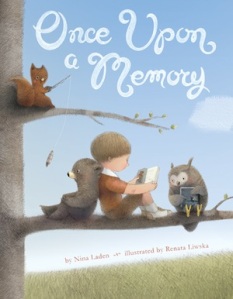“Does a book remember it once was a word?”
Once Upon a Memory (2013) by Nina Laden, illustrated by
Renata Liwska
Suggested age range: 4 and up
(Little, Brown, & Company, 40 pages)
Rating: 5/5 stars
Genre: Picturebook, Fantasy
Source: Library
The Book: A feather floating through a window sets in motion a boy’s curiosity about the world. He wonders whether a cakes, book, garden, and island remember their beginnings. One page opens with a question, such as “Does a statue remember it once was… and the opposite page reads the answer: “stone?” Laden’s verses leave gaps for the pictures to fill, and a sense of childlike wonder is reflected in both the text and images of Once Upon a Memory.
Liwska’s beautiful hand sketchings were inspired by her observation of animals in the natural world, and their antics throughout the story are enchanting and delightful. A textured feather graces one of the endpapers, and Liwska’s bears are expressive and perfect for the story. Here is a story that reminds us to step into childlike wonder and awe, and to reflect on love’s beginnings and the beauty of the natural world.
Spirituality in Once Upon a Memory: Maintaining a sense of wonder and awe at the world is a characteristic of spirituality, and the picturebook celebrates this attribute. Sometimes, marveling at the beauty of the natural world, or even pondering our origins can connect us to the Creator, and this story leaves open such possibility. It doesn’t matter that a young boy and bears are telling us this story visually; the book invites readers to consider a spiritual aspect of life—the importance of maintaining and nurturing a sense of wonder and awe at the world around us, as well as ourselves and our loved ones.
Exploring this Book with Readers: The book ends with a list of favorite things the author and illustrator remember. Items from the list include “eating grandma’s chocolate chip cookies,” “learning to speak French,” “sitting by the bonfire and listening to stories” and “getting letters and postcards from the mailbox.” The list ends with a question for the reader: “What are some of your favorite things to remember?” In addition to talking about these favorite things, readers might also draw some of their favorite memories. They could sing, dramatize, or dance their memories. In this way, readers have the opportunity to explore different literacies for expressing what is important to them. Even the part of the book asking, “Does an ocean remember it once was…rain?” represents an entire dance or drama that readers could create. A whole discussion could center on this notion of origins of the natural world. The book certainly reflects potential for a diversity of activities and curriculum to help readers enjoy and draw meaning from it.
The Final Word: I appreciated the rhyming verse in this story as well as the humorous and fantasy-filled pictures with their expressive bears, birds, and ducks. The cover of the book with the boy perched, reading in the tree with the owl and squirrel drew me to the story, as well as its title, reminiscent of fairy-tale beginnings. There are dinosaurs and even a raccoon. This is a delightful, warm, and reflective fantasy picturebook, perfect for a read-aloud, and perfect as a discussion starter for sharing memories and creating new ones. I love the double-page spread at the conclusion of the book, and think Liwska’s style is a fantastic match for Laden’s text.
